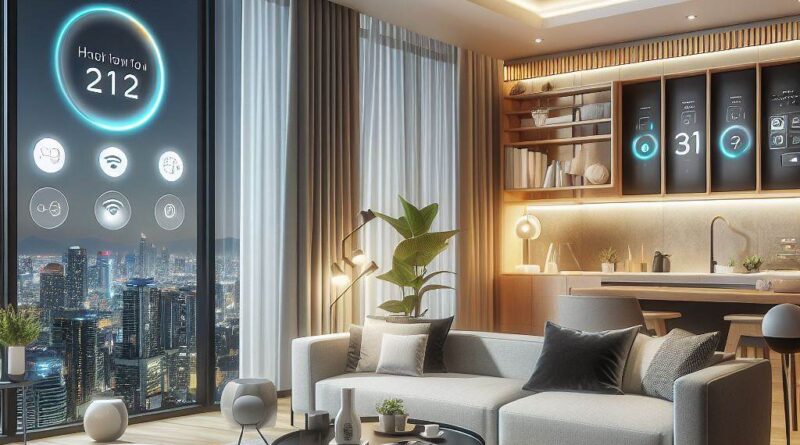8 Ways to Seamlessly Integrate Smart Home Tech
This post may contain affiliate links which means I may receive a commission for purchases made through links. As an Amazon Associate, I earn from qualifying purchases. Learn more on my Private Policy page.
When it comes to seamlessly integrating smart home tech, you want to ensure that you:
- Assess your current home tech setup
- Choose compatible smart devices
- Plan for network connectivity
- Consider voice control integration
- Incorporate smart lighting solutions
- Integrate smart climate control systems
- Implement home security automation
- Automate entertainment and media systems.
These eight strategies will help you create a cohesive and efficient smart home ecosystem that enhances your daily life.
But it’s not just about the devices – it’s about the ease and convenience they can bring to your lifestyle.
Assess Current Home Tech Setup
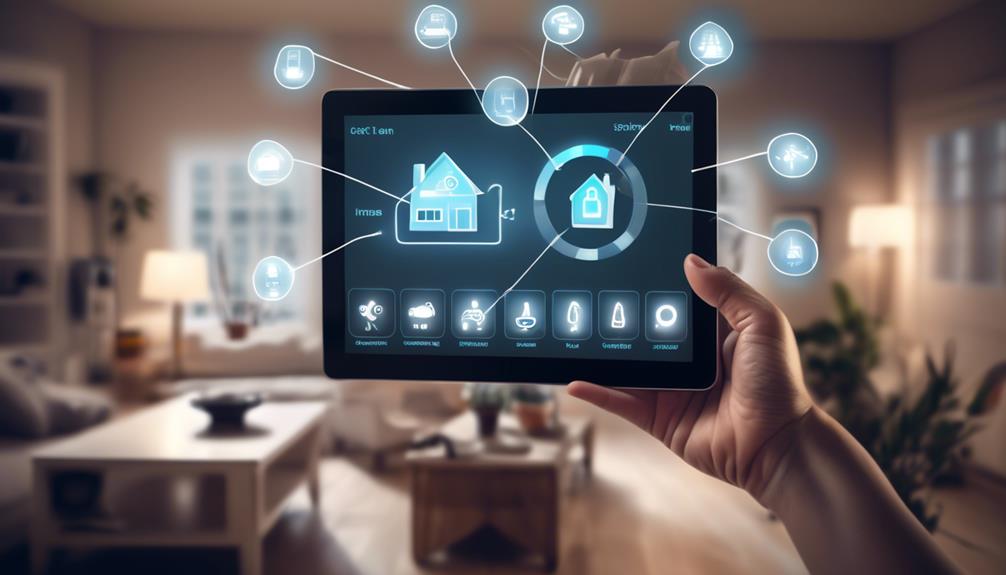
Assess your current home tech setup to identify potential areas for smart home integration. Start by evaluating the compatibility of your existing devices with smart home technology. Look for devices that can connect to a smart home hub or can be controlled remotely via a smartphone app. This will help you determine which devices can be seamlessly integrated into a smart home system without the need for extensive upgrades.
Upgrading infrastructure may be necessary to ensure that your home is equipped to support smart home technology. Assess your Wi-Fi network to determine if it can handle the increased demand from connected devices. Consider upgrading to a mesh Wi-Fi system to ensure strong and reliable connectivity throughout your home. Additionally, evaluate your electrical wiring to accommodate smart switches, outlets, and other smart devices that require power.
Assessing compatibility and upgrading infrastructure are critical steps in preparing your home for smart home integration. By identifying devices that can easily connect to a smart home system and ensuring that your home’s infrastructure can support the increased technological demands, you can set the stage for a seamless and efficient smart home setup.
Take the time to thoroughly evaluate your current home tech setup to lay the foundation for a successful smart home integration.
Choose Compatible Smart Devices
To ensure smooth integration, begin by selecting smart devices that are compatible with your existing home setup and align with your specific needs and preferences. When choosing smart devices, consider their compatibility with your current home technology. Look for devices that can seamlessly integrate with your existing smart home ecosystem. This will ensure that all your devices can communicate and work together effectively.
Before making a purchase, thoroughly research the compatibility of the smart devices with your existing setup. Check if they’re compatible with the smart hub or the virtual assistant you currently use. This will save you from the hassle of dealing with incompatible devices and the frustration of not being able to integrate them into your smart home system.
Additionally, consider the installation process of the smart devices. Opt for devices that offer easy installation and setup procedures. Some smart devices may require professional installation, while others can be easily set up by following simple instructions. Choosing devices with straightforward installation processes can save you time and effort, ensuring a hassle-free integration into your smart home setup.
Plan for Network Connectivity
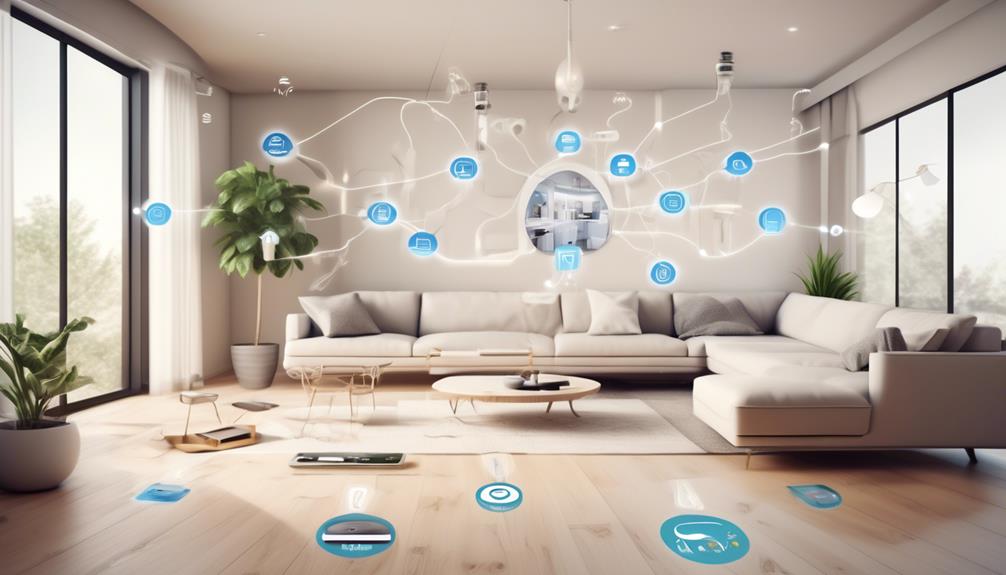
Consider the bandwidth and reliability of your home network when planning for the integration of smart home technology. Start by assessing WiFi coverage throughout your home to identify any dead zones or areas with weak signals. This will help you determine if you need to upgrade your routers and switches to ensure seamless connectivity for all your smart devices.
Upgrading routers and switches may be necessary to support the increased demand on your home network. Newer models offer improved performance, better range, and advanced features that can enhance the connectivity of your smart home devices. Look for routers with multiple antennas and support for the latest WiFi standards to ensure optimal coverage and speed. Additionally, consider investing in a mesh WiFi system to eliminate dead zones and provide consistent connectivity in every corner of your home.
When upgrading your network equipment, it’s essential to consider factors such as the size of your home, the number of devices connected, and the internet speed provided by your service provider. This will help you determine the type and number of access points, routers, and switches needed to support your smart home ecosystem effectively.
Consider Voice Control Integration
After upgrading your network equipment to ensure optimal connectivity for your smart home devices, explore integrating voice control for seamless and hands-free management of your smart technology. Voice control integration offers a convenient way to interact with your smart home devices and streamline daily tasks. Here are some key aspects to consider when implementing voice control for your smart home:
- Voice Assistant Compatibility: Ensure that the voice control system you choose is compatible with your preferred voice assistant, such as Amazon Alexa, Google Assistant, or Apple Siri. This compatibility will allow you to seamlessly control your smart home devices using voice commands tailored to your preferences.
- Home Automation: Integrate voice control with your home automation system to create customized routines and automate various tasks. This will enable you to control multiple smart devices simultaneously by simply issuing voice commands, making your daily routines more efficient.
- Voice Control Setup: Explore the setup process for voice control integration and ensure that it aligns with your technical expertise and preferences. Opt for user-friendly systems that offer straightforward setup instructions and intuitive interfaces for a hassle-free integration experience.
- Smart Appliance Integration: Consider the compatibility of voice control with a wide range of smart appliances, including thermostats, lighting systems, security cameras, and kitchen appliances. This will allow you to manage and monitor these devices with ease, enhancing the overall convenience of your smart home.
- Personalization and Flexibility: Look for voice control solutions that offer personalization options, allowing you to customize voice commands and responses to suit your unique needs. Additionally, prioritize systems that offer flexibility in terms of device compatibility and expandability, ensuring seamless integration as your smart home ecosystem grows.
Incorporate Smart Lighting Solutions
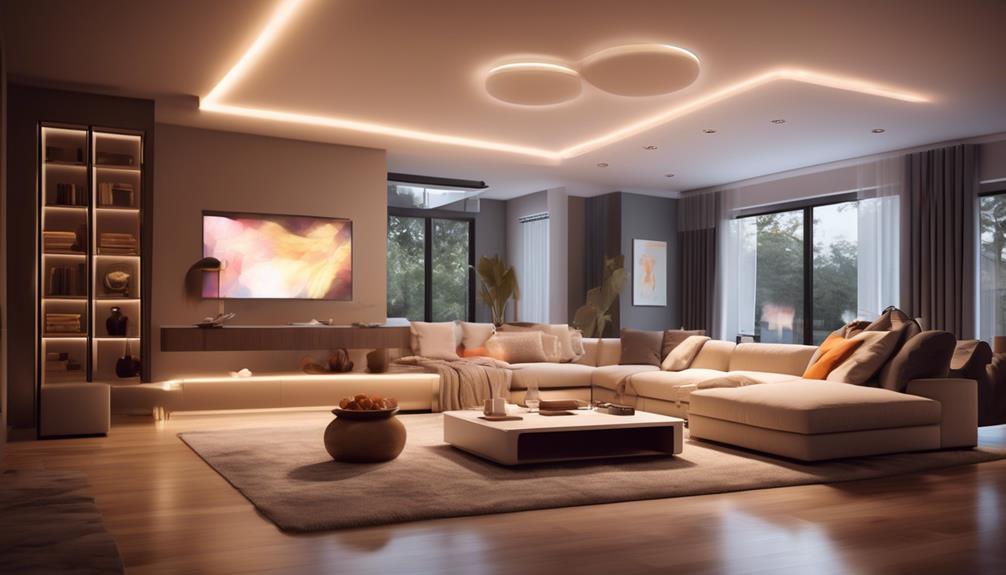
Explore integrating smart lighting solutions into your smart home setup for enhanced ambiance and energy efficiency. Lighting automation allows you to control your lights remotely, adjusting them to match your activities and mood. With energy efficiency in mind, smart lighting solutions can help you reduce your electricity consumption by automatically turning off lights in unoccupied rooms and adjusting brightness based on natural light levels.
Customized ambiance is at your fingertips with smart lighting. You can create different lighting scenes for entertaining, relaxing, or working. By integrating smart lighting solutions, you can schedule your lights to turn on and off at specific times, providing convenience and security when you’re away from home. With scheduling controls, you can simulate occupancy to deter potential intruders, or gradually dim the lights to signal bedtime.
Smart lighting solutions also offer the convenience of voice control integration, allowing you to adjust the brightness, color, and ambiance of your lights with simple voice commands. Additionally, motion sensors can be incorporated into your smart lighting system to automatically illuminate your path as you move through your home, further enhancing energy efficiency.
Incorporating smart lighting solutions into your smart home setup not only elevates the ambiance and convenience but also contributes to energy savings and efficiency. With the ability to customize lighting scenes and automate controls, smart lighting solutions offer a seamless and practical addition to your smart home ecosystem.
Integrate Smart Climate Control Systems
Enhancing your smart home setup with smart lighting solutions has revolutionized your living space; now, it’s time to seamlessly integrate smart climate control systems to further elevate your home’s comfort and efficiency.
With the integration of smart climate control systems, you can experience the convenience of monitoring and adjusting your home’s temperature and environment with just a few taps on your smartphone. Here are some key benefits to consider:
- Smart Thermostat: Upgrade to a smart thermostat to effortlessly regulate your home’s temperature, saving energy and money while ensuring optimal comfort for you and your family.
- Energy Efficiency: Smart climate control systems are designed to optimize energy usage, reducing your environmental impact and utility bills without sacrificing comfort.
- Climate Monitoring: Gain real-time insights into your home’s climate conditions, allowing you to make informed decisions to improve air quality and overall comfort.
- Remote Access: Enjoy the flexibility of adjusting your home’s climate settings from anywhere, ensuring a welcoming environment upon your arrival and maximizing energy savings when away.
Integrating smart climate control systems into your smart home setup not only enhances your comfort but also contributes to a more sustainable and efficient lifestyle. By embracing this technology, you can create a living space that adapts to your needs while prioritizing energy conservation and environmental responsibility.
Implement Home Security Automation
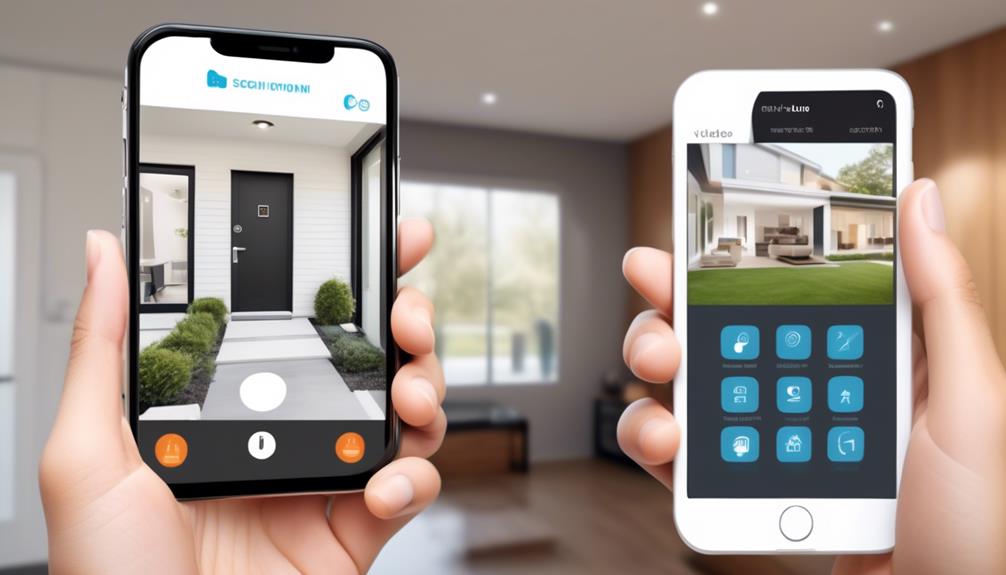
Considering the safety and protection of your home, implementing home security automation can provide peace of mind and convenience in monitoring and managing your property.
With remote monitoring, you can keep an eye on your home from anywhere, using your smartphone or other connected devices. This allows you to receive real-time alerts and view live video footage, ensuring that you’re always aware of what’s happening at your property, even when you’re not there physically.
Motion detection is another essential feature of home security automation. By installing motion sensors in strategic areas around your home, you can receive instant notifications when unexpected movement is detected. This not only helps to deter potential intruders but also allows you to take immediate action if any unusual activity is identified.
Furthermore, integrating motion detection with other smart home devices, such as lighting or cameras, can enhance the overall security of your property.
Automate Entertainment and Media Systems
As you secure your home with automation, you can also streamline your entertainment and media systems for a more connected and enjoyable living experience.
When it comes to entertainment automation, there are several ways to seamlessly integrate smart home tech to enhance your leisure time:
- Voice-Activated Controls: Imagine effortlessly adjusting your media systems with just a voice command, creating a hands-free entertainment experience that feels futuristic and convenient.
- Customizable Lighting Schemes: Set the mood for movie nights or gaming sessions by integrating smart lighting that adjusts to match the ambiance of your entertainment choices.
- Automated Content Suggestions: Experience a personalized entertainment journey with smart systems that learn your preferences and suggest media content tailored to your tastes.
- Integrated Sound Systems: Enjoy a fully immersive audio experience by seamlessly integrating your smart home tech with high-quality sound systems for an enhanced entertainment experience.
- Seamless Device Synchronization: Connect all your entertainment devices for a hassle-free experience, allowing you to seamlessly switch between different media and control them from a single interface.
Frequently Asked Questions
How Can I Ensure That My Smart Home Devices Are Compatible With Each Other and Won’t Cause Network Connectivity Issues?
To ensure your smart home devices are compatible and won’t cause network connectivity issues, start by researching and choosing devices that work well together. Use a central hub for seamless integration and regularly update firmware for optimal performance.
What Are Some Common Challenges or Obstacles in Integrating Smart Home Technology, and How Can They Be Overcome?
To ensure seamless integration of smart home tech, focus on overcoming compatibility issues. Check for firmware updates and ensure all devices are on the same network. Utilize a centralized hub for better control and consider professional installation for complex setups.
Are There Any Specific Considerations for Integrating Smart Climate Control Systems in Older or Non-Traditional Home Setups?
When integrating smart thermostats into older homes, consider the wiring compatibility and potential need for retrofitting. Ensure the system is compatible with your HVAC setup. Seek professional advice to ensure a seamless integration that meets your climate control needs.
What Are the Potential Security Risks Associated With Home Automation, and How Can I Mitigate Them?
To protect your smart home privacy and data, be wary of cybersecurity and remote access risks. Change default passwords, update software regularly, and use strong encryption. Limit access to authorized devices and networks.
How Can I Ensure That My Smart Home Entertainment and Media Systems Are Easily Accessible and Usable for All Members of My Household?
To ensure user accessibility for all household members, customize the interface of your smart home entertainment and media systems. By tailoring the controls and settings to individual preferences, you can make the technology easily usable for everyone.
Conclusion
Now that you’ve assessed your current home tech setup and chosen compatible smart devices, it’s time to plan for network connectivity and consider voice control integration.
Don’t forget to incorporate smart lighting solutions, climate control systems, home security automation, and entertainment and media automation for a seamless smart home experience.
With the right planning and implementation, you can enjoy the convenience and efficiency of smart home technology in no time.
